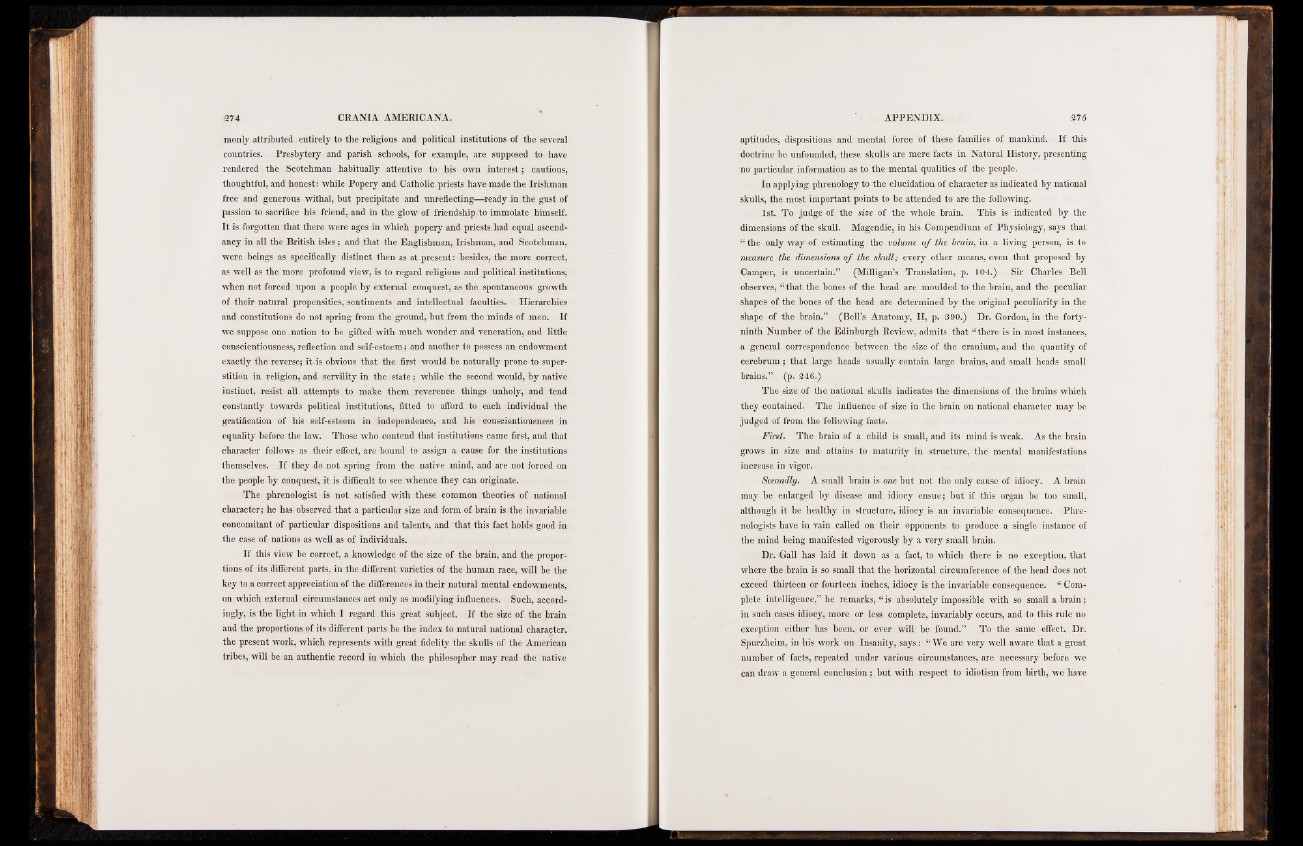
monly attributed. entirely to the religious and political institutions of the several
countries. Presbytery and parish schools, for example, are supposed to have
rendered the Scotchman habitually attentive to his own interest; cautious,
thoughtful, and honest: while Popery and Catholic priests have made the Irishman
free and generous withal, but precipitate and unreflecting—ready in the gust of
passion to sacrifice his friend, and in the glow of friendship to immolate himself.
It is forgotten that there were ages in which popery and priests had equal ascendancy
in all the British isles; and that the Englishman, Irishman, and Scotchman,
were beings as specifically distinct then as at present: besides, the more correct,
as well as the more profound view, is to regard religious and political institutions,
when not forced upon a people by external conquest, as the spontaneous growth
of their natural propensities, sentiments and intellectual faculties. Hierarchies
and constitutions do not spring from the ground, but from the minds of men. If
we suppose one nation to be gifted with much wonder and veneration, and little
conscientiousness, reflection and self-esteem; and another to possess an endowment
exactly the reverse; it is obvious that the first would be naturally prone to superstition
in religion, and servility in the state; while the second would, by native
instinct, resist all attempts to make them reverence things unholy, and tend
constantly towards political institutions, fitted to afford to each individual the
gratification of his self-esteem in independence, and his conscientiousness in
equality before the law. Those who contend that institutions came first, and that
character follows as their effect, are bound to assign a cause for the institutions
themselves. If they do not spring from the native mind, and are not forced on
the people by conquest, it is difficult to see whence they can originate.
The phrenologist is not satisfied with these common theories of national
character; he has observed that a particular size and form of brain is the invariable
concomitant of particular dispositions and talents, and that this fact holds good in
the case of nations as well as of individuals.
If this view be correct, a knowledge of the size of the brain, and the propor^
tions of its different parts, in the different varieties of the human race, will be the
key to a correct appreciation of the differences in their natural mental endowments,
on which external circumstances act only as modifying influences. Such, accordingly,
is the light in which I regard this great Subject. If the size of the brain
and the proportions of its different parts be the index to natural national character,
the present work, which represents with great fidelity the skulls of the American
tribes, will be an authentic record in which the philosopher may read the native
aptitudes, dispositions and mental force of these families of mankind. If this
doctrine be unfounded, these skulls are mere facts in Natural History, presenting
no particular information as to the mental qualities of the people.
In applying phrenology to the elucidation of character as indicated by national
skulls, the most important points to be attended to are the following.
1st. To judge of the size of the whole brain. This is indicated by the
dimensions of the skull. Magendie, in his Compendium of Physiology, says that
“ the only way of estimating the volume o f the brain, in a living person, is to
measure the dimensions o f the skull; every other means, even that proposed by
Camper, is uncertain.” (Milligan’s Translation, p. 104.) Sir Charles Bell
observes, “ that the bones of the head are moulded to the brain, and the peculiar
shapes of the bones of the head are determined by the original peculiarity in the
shape of the brain.” (Bell’s Anatomy, II, p. 390.) Dr. Gordon, in the forty-
ninth Number of the Edinburgh Review, admits that “ there is in most instances,
a general correspondence between the size of the cranium, and the quantity of
cerebrum; that large heads usually contain large brains, and small heads small
brains.” (p. 246.)
The size of the national skulls indicates the dimensions of the brains which
they contained. The influence of size in the brain on national character may be
judged of from the following facts.
First. The brain of a child is small, and its mind is weak. As the brain
grows in size and attains to maturity in structure, the mental manifestations
increase in vigor.
Secondly. A small brain is one but not the only cause of idiocy. A brain
may be enlarged by disease and idiocy ensue; but if this organ be too small,
although it be healthy in structure, idiocy is an invariable consequence. Phrenologists
have in vain called on their opponents to produce a single instance of
the mind being manifested vigorously by a very small brain.
Dr. Gall has laid it down as a fact, to which there is no exception, that
where the brain is so small that the horizontal circumference of the head does not
exceed thirteen or fourteen inches, idiocy is the invariable consequence. “ Complete
intelligence,” he remarks, “ is absolutely impossible with so small a brain;
in such cases idiocy, more or less complete, invariably occurs, and to this rule no
exception either has been, or ever will be found.” To the same effect, Dr.
Spurzheim, in his work on Insanity, says: “We are very well aware that a great
number of facts, repeated under various circumstances, are necessary before we
can draw a general conclusion; but with respect to idiotism from birth, we have